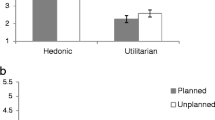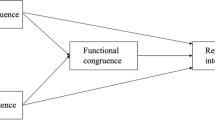Abstract
We study the impact of consumers’ goal orientation on their preference between high-quality and low-priced products. Consistent with our theorizing, we find that US (Korean) consumers, who are more promotion (prevention) oriented, prefer high-quality (vs. low-priced) products because they assign more weight to quality in their choice. In addition, we identify a boundary condition of the effect by showing that it is mitigated for products for which safety is a salient feature. We also rule out price/quality perceptions, regret, and price-quality association as rival explanations of our results. We conclude by discussing the theoretical and managerial implications of the current research.

Similar content being viewed by others
Notes
We aimed for 80 participants in each country, but many more were recruited in South Korea due to a clerical error. The resultant imbalance in the study design may reduce the statistical power of detecting the proposed effect, thus providing a conservative test of our predictions.
References
Aaker JL, Lee AY (2001) I seek pleasures and we avoid pains: The role of self regulatory goals in information processing and persuasion. J Consum Res 28:33–49
Ahtola OT (1984) Price as a give component in an exchange theoretic multicomponent model, vol 11. Association for Consumer Research, Ann Arbor
Arnold MJ, Reynolds KE (2009) Affect and retail shopping behavior: understanding the role of mood regulation and regulatory focus. J Retail 85(3):308–320
Avnet T, Tory Higgins E (2006) How regulatory fit affects value in consumer choices and opinions. J Mark Res 43:1–10
Bell DR, Lattin JM (2000) Looking for loss aversion in scanner panel data: the confounding effect of price-response heterogeneity. Mark Sci 19(2):185–200
Bettman J, Luce MF, Payne J (1998) Constructive consumer choice processes. J Consum Res 25(December):187–217
Bornemann T, Homburg C (2011) Psychological distance and the dual role of price. J Consum Res 38:490–504
Bronnenberg BJ, Dhar SK, Dube J-P (2007) Consumer packaged goods in the united states: national brands, local branding. J Mark Res 44(1):4–13
Chartrand T, Huber J, Shiv B, Tanner R (2008) Nonconscious goals and consumer choice. J Consum Res 35:189–201
Chernev A (2004) Goal orientation and consumer preference for the status quo. J Consum Res 31(December):557–65
Choi W, Sun H, (lucy) liu Y, (allan) chen H (2020) Guess who buys cheap? the effect of consumers’, goal orientation on product preference. J Consum Psychol 30(3):506–514
Fong N, Simester D, Anderson E (2011) Private label vs. national brand price sensitivity: evaluating non-experimental identification strategies. MIT Working Paper
Forster J, Tory Higgins E, Bianco AT (2003) Speed/accuracy decisions in task performance: built in trade off or separate strategic concerns? Organ Behav Hum Decis Process 90:148–64
Hardie BGS, Johnson EJ, Fader PS (1993) Modeling loss aversion and reference dependence effects on brand choice. Mark Sci 12(4):378–94
Hayes AF (2018) PROCESS: A versatile computational tool for observed variable mediation, moderation, and conditional process Modeling. Guilford Press
Heath Chip, Larrick Richard, George W u (1999) Goals as reference points. Cogn Psychol 38:79–109
Heath T, Chatterjee S (1995) Asymmetric decoy effects on lower quality versus higher quality brands: meta analytic and experimental evidence. J Consum Res 22:268–84
Higgins E (1998) Advances in experimental psychology, vol 30. Academic Press, San Diego
Higgins E (2002) How self regulation creates distinct values: the case of promotion and prevention decision making. J Consum Psychol 12(3):177–91
Higgins E, Idson L, Freitas AL, Spiegel S, Molden DC (2003) Transfer of value from fit. J Pers Soc Psychol 84:1140–53
Higgins E (1997) Tory beyond pleasure and pain. Am Psychol 52:1280–200
Higgins T, Friedman R, Harlow R, Idson LC, Ayduk O, Taylor A (2001) Achievement orientations from subjective histories of success: promotion pride versus prevention pride. Eur J Soc Psychol 31 (1):3–23
Hoch S, Banerji S (1993) When do private labels succeed? Sloan Manag Rev 34:57–67
Hwang M, Thomadsen R (2016) How point-of-sale marketing mix impacts national-brand purchase shares. Manag Sci 62(2):571–590
Idson L, Liberman N, Tory Higgins E (2000) Distinguishing gains from nonlosses and losses from nongains: a regulatory focus perspective on hedonic intensity. J Exp Soc Psychol 36:252–74
Lalwani A, Shavitt S (2013) You get what you pay for? self-construal influences price-quality judgments. J Consum Res 40:255–267
Leder S, Florack A, Keller J (2013) Thoughts about possible failure: regulatory focus and the anticipation of regret. Soc Cogn 31(3):349–373
Lee A, Aaker J, Gardner W (2000) The pleasures and pains of distinct self construals: the role of interdependence in regulatory focus. J Pers Soc Psychol 78(June):1122–34
Lee A, Keller P, Sternthal B (2010) Value from regulatory construal fit: the persuasive impact of fit between consumer goals and message concreteness. J Consum Res 36:735–47
Lee L, Ariely D (2006) Shopping goals, goal concreteness and conditional promotions. J Consum Res 33(1):60–70
Luce MF (1998) Choosing to avoid: coping with negatively emotion-laden consumer decisions. J Consum Res 24(March):409–33
Maimaran M, Simonson I (2011) Multiple routes to self versus other expression in consumer choice. J Mark Res 48(4):755–66
Mogilner C, Aaker JL, Pennington GL (2008) Time will tell: the distant appeal of promotion and imminent appeal of prevention. J Consum Res 34(February):670–81
Nowlis SM, Simonson I (1997) Attribute task compatibility as a determinant of consumer preference reversals. J Mark Res 34(2):205–18
Rao A, Monroe KB (1988) The moderating effect of prior knowledge on cue utilization in product evaluations. J Consum Res 15(September):253–64
Richardson P, Dick A, Jain A (1994) Extrinsic and intrinsic cue effects on perceptions of store brand quality. J Mark 58(4):28–36
Sethuraman R, Cole C (1999) Factors influencing the price premiums that consumers pay for national brands over store brands. J Prod Brand Manag 8(4):340–51
Sethuraman R, Cole C (2007) Understanding impulsive eaters’ choice behaviors: The motivational influences of regulatory focus. J Mark Res 44(2):297–308
Shiv B, Carmon Z, Ariely D (2005) Placebo effects of marketing actions: consumers get what they pay for. J Mark Res 42:383–93
Simonson I, Kramer T, Young M (2003) Effect propensity. Organ Behav Hum Decis Process 95(2):158–74
Simonson I, Nowlis S, Lemon K (1993) The effect of local consideration sets on global choice between lower price and higher quality. Mark Sci 12(4):357–377
Simonson I, Tversky A (1992) Choice in context: tradeoff contrast and extremeness aversion. J Mark Res 29:281–95
Steenkamp J-B, Van Heerde H, Geyskens I (2010) What makes consumers willing to pay a price premium for national brands over private labels? J Mark Res 47(6):1011–24
Van H, Harald EG, Pauwels K (2008) Winners and losers in a major pricewar. J Mark Res 45(October):499–518
Wakefield K, Inman J (2003) Situational price sensitivity: the role of consumption occasion, social context and income. J Retail 79(4):199–212
Wan EW, Hong J, Sternthal B (2009) The effect of regulatory orientation and decision strategy on brand judgments. J Consum Res 35(6):1026–1038
Wang J, Torelli CJ, Lalwani AK (2020) The interactive effect of power distance belief and consumers’ status on preference for national (vs. private-label) brands. J Bus Res 107:1–12
Yan D, Sengupta J (2011) Effects of construal level on the price quality relationship. J Consum Res 38:376–89
Zeithaml V (1988) Consumer perceptions of price, quality, and value: a means end model and synthesis of evidence. J Mark 52:2–22
Author information
Authors and Affiliations
Corresponding author
Ethics declarations
Conflict of Interest
On behalf of all authors, the corresponding author states that there is no conflict of interest
Additional information
Publisher’s Note
Springer Nature remains neutral with regard to jurisdictional claims in published maps and institutional affiliations.
Appendices
Appendix A: Stimuli and Measures for Study 1
(The stimuli and measures below were presented to the participants in the USA. They were translated into Korean for participants in South Korea. Prices were converted at an exchange rate of $1=  1,199).
1,199).
Product Choice
Which tablet would you purchase? _ Product A _ Product B
Weight on Price and Quality
How much attention did you pay to price and quality, respectively, in determining your product preference on the previous page?
Price (1 = very little; 7 = a lot)
Quality (1 = very little; 7 = a lot)
Price and Quality Perceptions (1 = low; 7 = high)
Please answer the following questions.
The quality of Product A is
The price of Product A is
The quality of Product B is
The price of Product B is
Regret (1 = not at all; 7 = very much)
Please answer the following questions.
I should have chosen differently.
I regret the product choice I made.
I now realize how much better the other choice is.
If I were to go back in time, I would choose something different to buy.
Price-Quality Association (1 = not at all; 7 = very much)
Please answer the following questions.
Generally speaking, the higher the price of a tablet, the higher the quality.
The old saying “you get what you pay for” is generally true for a tablet.
The price of a tablet is a good indicator of its quality.
You always have to pay a bit more for the best tablet.
Perceived Differences in Price and Quality (1 = strongly disagree; 4 = neutral; 7 = strongly agree)
Please indicate the extent to which you agree or disagree with the following statements.
The prices of two tablets are different.
The quality of two tablets are different.
Goal Orientation Measures (from [22]) (1 = never or seldom; 7 = very often)
Please answer the following questions.
-
1.
Compared to most people, are you typically unable to get what you want out of life? (r)
-
2.
Growing up, would you ever “cross the line” by doing things that your parents would not tolerate? (r)
-
3.
How often have you accomplished things that got you “psyched” to work even harder?
-
4.
Did you get on your parents’ nerves often when you were growing up? (r)
-
5.
How often did you obey rules and regulations that were established by your parents?
-
6.
Growing up, did you ever act in ways that your parents thought were objectionable? (r)
-
7.
Do you often do well at different things that you try?
-
8.
Not being careful enough has gotten me into trouble at times. (r)
-
9.
. When it comes to achieving things that are important to me, I find that I don’t perform as well as I ideally would like to do. (r)
-
10.
I feel like I have made progress toward being successful in my life.
-
11.
I have found very few hobbies or activities in my life that capture my interest or motivate me to put effort into. (r)
(r – reversed coded; items 1, 3, 7, 9, 10 and 11 measure promotion orientation; items 2, 4, 5, 6, 8 measure prevention orientation)
Appendix B: Stimuli and Measures in Study 2
Manipulation check of safety in the pretest
For this product, safety is really important (1 = strongly disagree; 7 = strongly agree)
The goal orientation manipulation
Promotion orientation condition
Among the courses offered this semester, one course is especially important to you. What academic strategies or methods are you using in studying for this course in order to get positive outcomes (e.g., getting a good grade)?
Prevention orientation condition
Among the courses offered this semester, one course is especially important to you. What academic strategies or methods are you using in studying for this course in order to avoid negative outcomes (e.g., failing the course)?
Control condition
As the semester is near its end, please carefully recall the courses you’ve taken. Among those courses, there may some that you really liked and some that you really hated. Please list the courses from the liked to hated (list at least 4 courses).
Goal Orientation Manipulation Check
When you were writing down your academic strategies, to what extent were you focused on getting positive outcomes? (1 = Not at all; 7 = a lot)When you were writing down your academic strategies, to what extent were you focused on avoiding negative outcomes? (1 = Not at all; 7 = a lot)
Purchase intention
1 = I’m more willing to buy product A; 7 = I’m more willing to buy Product B
Weights on product quality and price
When purchasing the above product, I’m focused more on product quality (1 = strongly disagree; 7 = strongly agree)When purchasing the above product, I’m focused more on product price (1 = strongly disagree; 7 = strongly agree)
Price and quality perceptions
Product A’s price is very high (1 = strongly disagree; 7 = strongly agree)Product A’s quality is very high (1 = strongly disagree; 7 = strongly agree)Product B’s price is very high (1 = strongly disagree; 7 = strongly agree)Product B’s quality is very high (1 = strongly disagree; 7 = strongly agree)
Regret
I may regret it after I make this purchase (1 = strongly disagree; 7 = strongly agree)
Price-quality association
High price means high quality (1 = strongly disagree; 7 = strongly agree)(Original stimuli in Chinese. English translation provided for illustration.)
Rights and permissions
About this article
Cite this article
Chen, H.(., Choi, W., Liu, Y.(. et al. More or Less? Consumer Goal Orientation and Product Choice. Cust. Need. and Solut. 8, 16–26 (2021). https://doi.org/10.1007/s40547-021-00114-z
Accepted:
Published:
Issue Date:
DOI: https://doi.org/10.1007/s40547-021-00114-z






